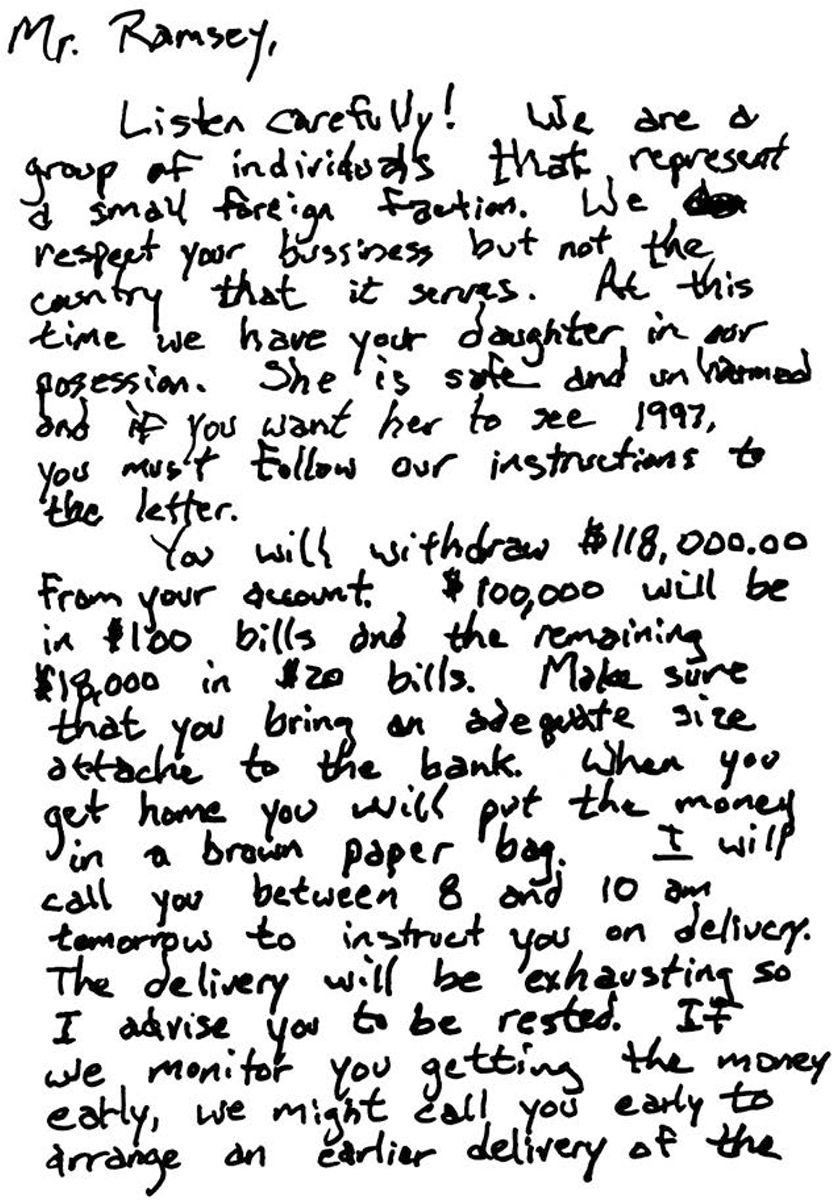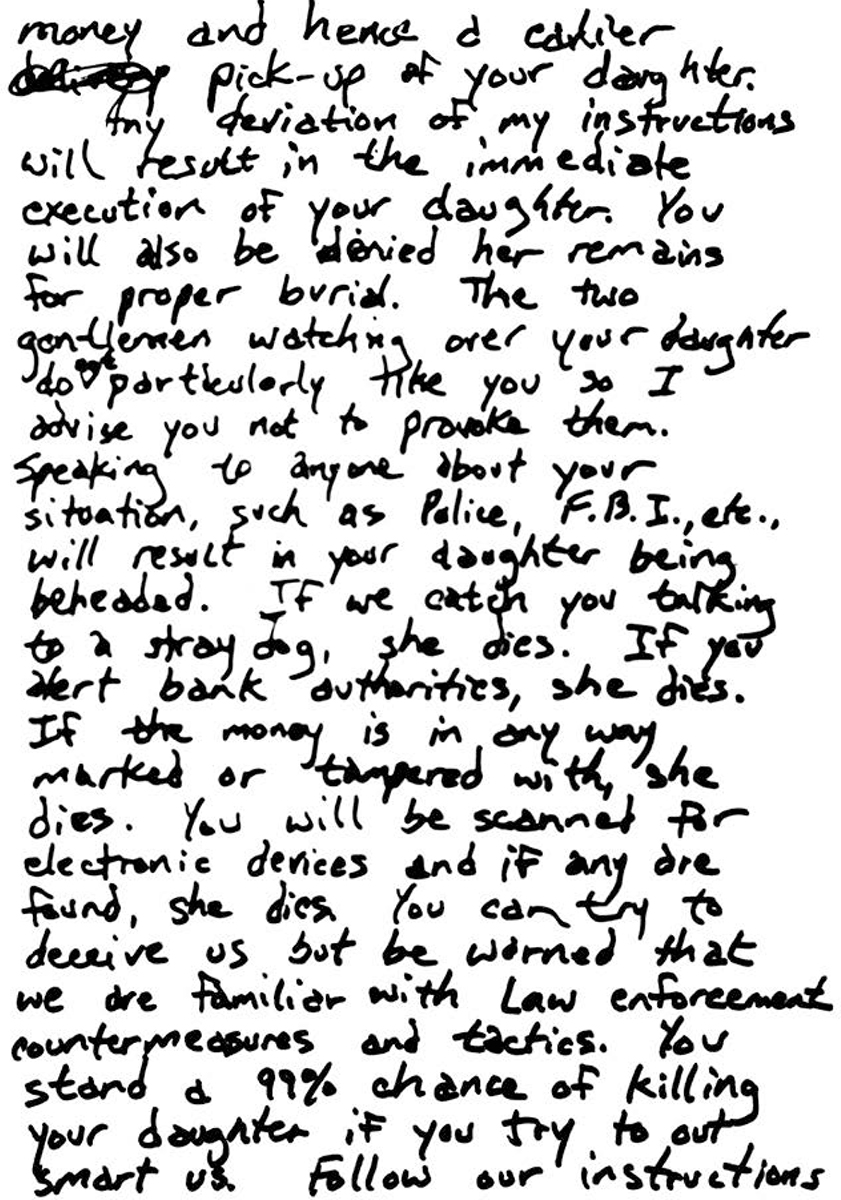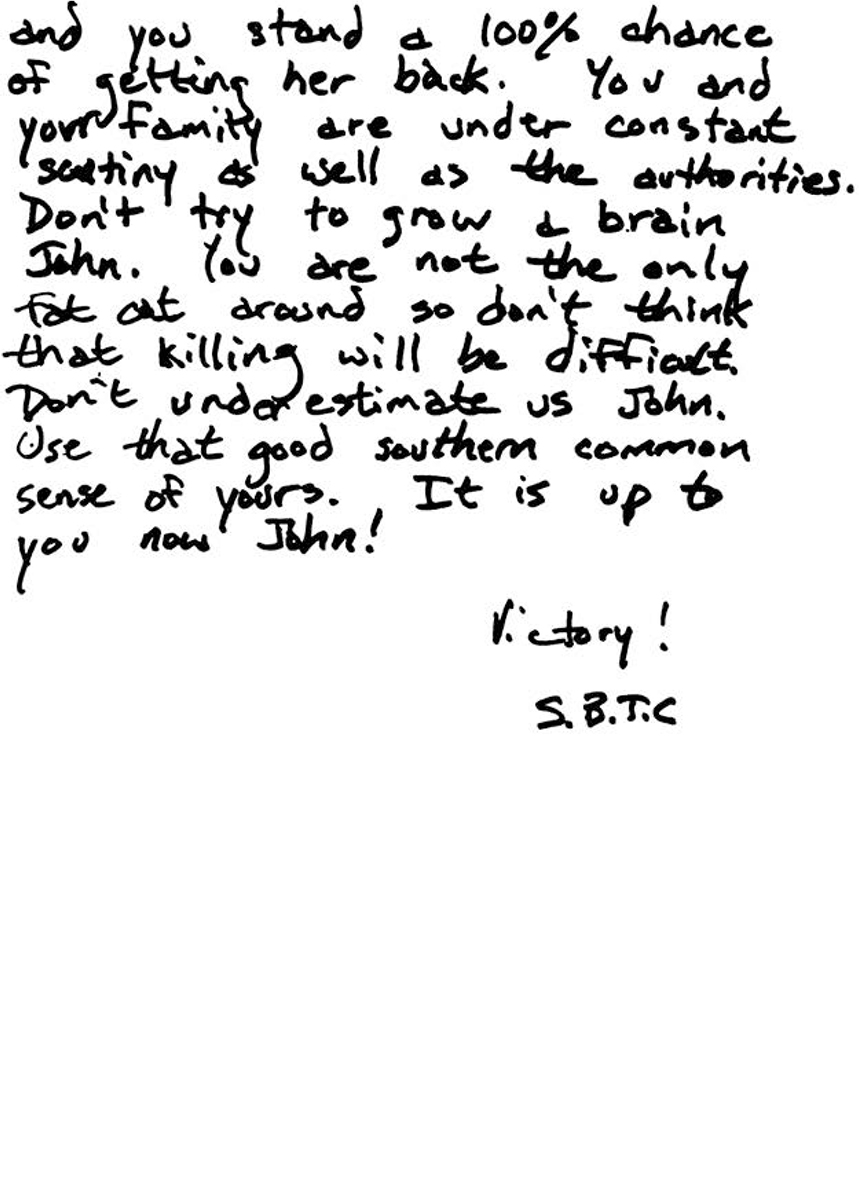CHAPTER 4
RANSOM NOTE
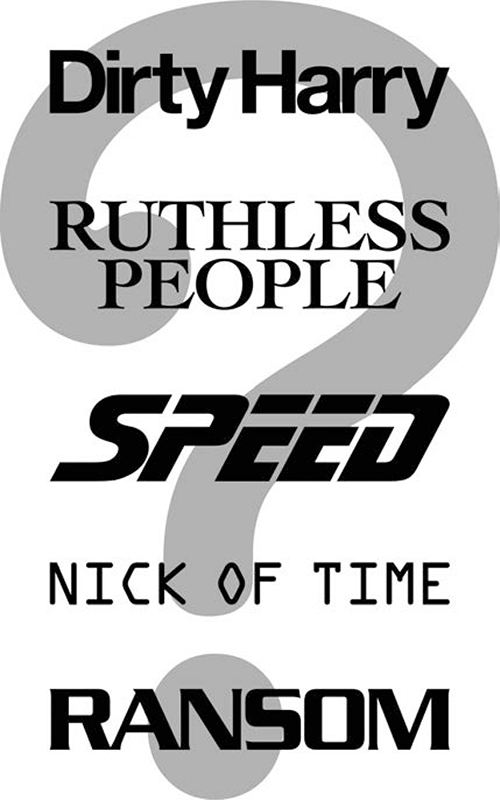
Five movies examined for ransom note phrasing. © Tommy Collier.
CHRONOLOGY
Lines from all these movies, which were in circulation before the Ramsey ransom note was found, were compared to it. Police reports said John and Patsy Ramsey didn’t go out to see movies (BPD Report #5-431.):
1971—Dirty Harry released
1986—Ruthless People released
1994—Speed released
1995—Nick of Time released
1996 (November)—Ransom released
THE RANSOM NOTE was the first solid evidence discovered at the scene. To see and read the words of the person who killed JonBenét Ramsey, or had knowledge of her murder, is still eerie even after all these years.
While there is no profanity in the ransom note, the odd and perverse personality of the writer seeps through its words. The note conjures images designed to strike pure terror in the heart of a parent of a kidnapped child via words such as “beheaded.” Parts of the note seem disjointed, while others seem strangely concise. There are hints of terrorism and fragments of text from movie scripts. The first paragraph includes spelling and punctuation errors and perhaps a minor shaky handwriting disguise, but in the remaining text there are no errors, and the block-style writing evens out. Although the note seems to indicate some knowledge of the family, it chillingly alludes to the Ramseys’ daughter but never once mentions her by name. According to forensic psychiatrists, such a strategy helps a killer to disassociate from the victim as a person. But it could also mean the killer didn’t know her name or how to spell it.
The killer or accomplice who wrote the ransom note used a black Sharpie, a felt-tip pen, that was in the Ramsey home. “United States Secret Service document Examiner Larry Stewart found the pen marked CBI exhibit 292 had the same type of ink as was on the ransom note.” (BPD Report #3-199.)
The note is approximately 372 words in length, depending on how you count abbreviations, and two-and-a-half-pages long. It was left on the back spiral staircase between the first and second floors of the Ramsey home, on one of the lower steps, where Patsy found it. She later said those were the stairs she always used to come downstairs. The pen with the same ink as the ink used to write the note was found with pens in the first-floor kitchen area near the back staircase. It may be one of the longest, if not the longest, ransom notes in recent history, according to researchers.
A close family friend in the home with the Ramseys that morning stated, “Whoever wrote the note has a very superficial knowledge about John Ramsey. They probably got the stuff from reading bibliographies [sic] in the press about Patsy because she’s from the South” (BPD Report #5-52). Another close friend in the home with the family that morning said the note contained some “fakey stuff” and seemed “so personal.” (BPD Report #5-413.)
When the Ramsey home was part of a holiday tour of homes in Boulder in 1994, flyers about the Ramseys were made available to visitors. According to the Boulder Police Department, there was a “copy of the flyer found in the basement near where JonBenét’s body was found. This flyer provides information regarding the background on the family and could contain information observed in the ransom note.” (BPD Report #19-1.)
With regard to the ransom note, one of the detectives familiar with the investigation later remarked, “Imagine what type of person would be able to write those words while in essence lying in wait for the Ramseys to come home that Christmas night, knowing at least in part what was going to happen. What kind of sheer, coldblooded ruthlessness would it take by the parents to write these ransom words after torturing, sexually assaulting and killing their little girl?” He added, “Or what about the person who might have written the note days earlier, knowing what was planned for the child?”
The language in the note generated tremendous speculation. One theory suggested that parts of the ransom note might have used lines from movies involving kidnappings. Boulder County Sheriff Homicide Detective Steve Ainsworth, on loan to the Boulder District Attorney’s Office for the investigation, remembered hearing quotes similar to those in the ransom note in a Dirty Harry movie. Detective Ainsworth talked with other investigators to see if they might remember other movies that might have similar language.
Ainsworth and retired Colorado Springs Homicide Detective Lou Smit compared the words in Dirty Harry and several other movies involving ransoms. Smit was hired by the Boulder District Attorney with approval from the Boulder Police Department to work the homicide case and provide a different perspective since he did not live in the Boulder area.
Ainsworth and Smit reasoned that, if the author had used quotes from movies demanding ransoms, then he would have had to spend time watching those movies and gathering the quotes. They concluded it was possible the killer brought the quotes to the Ramsey home and wrote the ransom note before kidnapping and killing JonBenét, or took Patsy’s tablet outside of the home and wrote the ransom note earlier before bringing it back into the home.
The first Dirty Harry movie is about the search for the Zodiac Killer, a real-life serial killer who operated in the San Francisco area during the late 1960s. He murdered at least five people and claimed to have killed many more. The Zodiac Killer has never been apprehended.
The Dirty Harry movie featured a dramatic and suspenseful beginning, much like the Ramsey murder did, as well as a sinister and macabre story line:
The bells toll mournfully as the movie camera zooms in on a list of San Francisco police officers who have been killed in the line of duty. It pans up to a San Francisco Police Department badge. Then it moves down the list of killed officers, whose names have been memorialized in stone. The badge is visible once more before dissolving into the scope of a sniper’s rifle being sighted from the top of a high-rise building. The music intensifies; the sniper locks his rifle crosshairs on a young woman swimming in a rooftop pool a few streets away. As the weapon fires, the rifle-scope follows the woman as she’s hit and sinks into the water of the pool. It’s the opening and classic scene from Dirty Harry, the first in a series of movies produced about a detective, Harry Callahan, played by actor Clint Eastwood.
The serial killer in the Dirty Harry movie threatens the mayor of San Francisco for ransom in exchange for not killing more people. The comparisons:
Ramsey Ransom Note
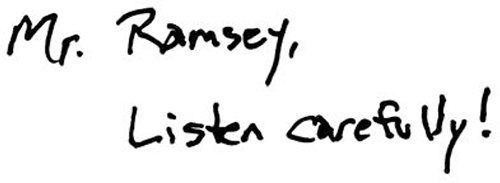
Dirty Harry
“Now listen to me carefully. Listen very carefully.” (The killer says this while beating Callahan.)
“Now listen.” (The killer says this to the mayor of San Francisco.)
Ramsey Ransom Note

Dirty Harry
“If you talk to anyone, I don’t care if it’s a Pekingese pissing against a lamppost, the girl dies.” (The killer says this to Callahan in a call related to the ransom drop.)
Ramsey Ransom Note

Dirty Harry
“It sounds like you had a good rest. You’ll need it.” (The killer says this to Callahan.)
The person who wrote the ransom note to John Ramsey about JonBenét warned him four times what to do to get his daughter back, or “she dies.” The killer in the movie Dirty Harry warns what to do three times or “the girl dies.”
Another movie, Speed, involves a bus filled with passengers that’s been rigged with a bomb. The man requesting money says the bus will explode if it slows to less than 50 miles an hour.
Speed features actors Keanu Reeves, who plays a Los Angeles police officer named Jack Traven, and Sandra Bullock, who plays a passenger on the bus who becomes its driver after the actual driver is accidentally shot. The ransom demand is $3.7 million dollars for the killer to remotely disarm the bomb.
Ramsey Ransom Note

“Do not attempt to grow a brain.” (The killer says this to Traven.)
A third movie compared to the ransom note, Nick of Time, stars actor Johnny Depp, who plays a protective father named Gene Watson. Watson’s daughter is kidnapped and, to get her back, Watson is supposed to kill the governor of California. He is told he is being constantly watched and supervised by one of the kidnappers.
Ramsey Ransom Note

Nick of Time
“You talk to a cop; you even look at a cop too long and your daughter’s dead … I’ll kill her myself. Cut the head off right in front of you.” (The killer says this to Watson.)
Ramsey Ransom Note

Nick of Time
“Don’t forget. I’ll be watching you.” (The killer says this to Watson.)

Nick of Time
“I need you to listen to me carefully. Three lives depend on it … Very carefully.” (Watson says this to the governor of California.)
The fourth movie compared to the Ramsey ransom note, Ruthless People, stars Danny DeVito, who plays millionaire Sam Stone, and Bette Midler, who plays Stone’s despised wife. Stone wants to get rid of his wife, but she’s kidnapped before he can. The kidnapper calls Stone using a disguised voice.
Ramsey Ransom Note

Ruthless People
“Listen very carefully!” (The kidnapper says this to Stone.)
Ramsey Ransom Note

Ruthless People
“You will be watched at all phases of execution.” (The kidnapper says this to Stone.)
The movie Ransom starring actors Mel Gibson and Rene Russo was showing throughout the country, including in Boulder, at the time of JonBenét’s murder. It involves the kidnapping of the son of a very wealthy and influential high-profile businessman named Tom Mullen. The first few minutes of the film show Mullen and his son playing hide-and-seek during a party at their home.
After the kidnappers take Mullen’s son, they e-mail Mullen a video of the child with silver duct tape over his eyes. (JonBenét had black duct tape placed over her mouth.) One of the kidnappers calls Mullen using a mechanically disguised voice and gives him detailed instructions on how to get his son back. He details the terms, including denominations of the money and the type of briefcase to use, and warns Mullen not to involve the police or the FBI. The kidnapper also says Mullen’s family is being watched and gives conditions that, if violated, will result in the child being killed.
None of the movies police compared with the note was found in the Ramsey home. All videos in the Ramsey home had been made for children to watch. Boulder police checked numerous video stores to see if John and Patsy had rented any movies with kidnapping themes. They hadn’t, as far as investigators were able to determine. The couple also told police they didn’t go out to watch movies (BPD Report #5-431).
Four of the five movies noted use words such as “listen,” “listen up,” “now listen to me carefully,” “now listen,” and “listen very carefully,” all of which are echoed in the JonBenét ransom note:

There is other unusual wording in the demand note, which ends with:
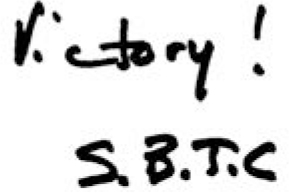
Although there have been many theories about what “S.B.T.C” stands for, no one has found the answer yet. When Boulder Police Department investigators searched for a connection to S.B.T.C, they found phrases that matched but appeared to lead nowhere: Southern Bell Telephone Company (BPD Report #1-813), a family in Florida with those initials on their license plate (BPD Report #1-618), Santa Barbara Tennis Club (BPD Report #26-189) and Saved by the Cross (BPD Report #26-148). There were other matched comparisons, but no leads.
Experts say $118,000 is a peculiar amount of money to request for a ransom amount. Other actual ransom notes in kidnappings typically request amounts in evenly rounded numbers, according to research.
The amount in the Ramsey ransom note is also close to the amount John Ramsey received from a deferred compensation bonus from his employer that year. But it wasn’t exact. John’s bonus was slightly more than $118,000—it was $118,117.50.
“How many people would know what my bonus was?” John Ramsey later asked. “If I or my wife were writing that note, why would we choose a ransom amount that would cause the police to ask us questions about it because it was close to my bonus amount?”
John kept his pay stubs in his unlocked desk at home, where a stranger could have found them. Almost immediately after investigators working for the Ramseys told two Boulder Police Department detectives about the bonus and the pay stubs, this information—including payment amounts—was leaked to the media, and another brick was cemented in the wall of public opinion against the Ramseys.
What wasn’t reported publicly were ties that linked the ransom request amount of $118,000 with two former employees of Access Graphics, where John Ramsey was CEO.
The BPD report states that one employee told police that it was an “‘odd coincidence that $118,000 happens to be the amount of the difference between what we W-2’d [this deleted pronoun from the report referred to the person fired] as a result of what we felt we gave up in the settlement and the promissory note, the unpaid note, the promissory note. And it’s such an obtuse connection, but since you asked, $118,000.’ (Pertaining to a settlement: re: [the ex-employee] who stole money from Access Graphics)” (BPD Report #5-3295).
The controller of Access Graphics at the time stated about the same former employee that the person had been “involved in a fraud for approximately that amount” (BPD Report #5-795).
And a second employee stated: “It is either the bonus or also a number close to the claim that [ex-employee] made against the company.” (BPD Report #5-3488.)
One recurring rumor about the case stated that a book found in the Ramsey home was connected to the ransom note. The Ramseys said they didn’t have the book in question, but rumors and publicity still swirled that they did and used ideas from it in the murder of their daughter. Mindhunter: Inside the FBI’s Elite Serial Crime Unit, was written by retired FBI profiler John Douglas and published in August 1996. Douglas’s book details how profilers working from crime scene evidence try to predict the behavior, motivation and patterns of serial killers. The book also discusses the limitations of profiling and how a profile is apt to fit a lot of people and can’t substitute for hard evidence.
Douglas was hired by the Ramsey attorneys. He thought the killer was an intruder who specifically hated John Ramsey. With the permission of the Ramsey attorneys, Douglas conferred with the FBI, the Colorado Bureau of Investigations and the Boulder Police Department. Another former FBI profiler, Greg McCrary, who worked for the prosecution, felt the Ramseys were involved in the death of their daughter and countered Douglas’s conclusions. Both men were criticized publicly, which was typical of the case. And anyone who publicly declared support for one side or the other automatically qualified as a source for gossip shows, tabloids and sometimes traditional media outlets.
The rumor mill asserted the Douglas book also contained the “Listen carefully” phrase found in the ransom note. Although there is no information in the WHYD Investigative Archive that indicates the Douglas book was found in the Ramsey home and introduced as evidence, mounting rumors about it further damaged the public’s view of John and Patsy Ramsey.
Another rumor about the ransom note concerned the phrase “Use that good southern [sic] common sense of yours.”
Information was circulated that this was an “insider” phrase that John and Patsy used. It was rumored that this was a family joke because John was not a Southerner, and Patsy teased him about this fact. John was born in Nebraska and raised for the most part in Michigan. He lived in Atlanta for twenty years before moving to Boulder in 1991. Family friends Mike Bynum and Susan Stine, as well as Patsy and John, have said the couple never talked or joked about whether or not John was a Southerner. It wasn’t an issue.
Also questioned: the use of the slang term “fat cat” in the ransom note: “You are not the only fat cat around, so don’t think that killing will be difficult.”
The term “fat cat” was first used in the 1920s to refer to a wealthy political donor, but it has evolved to mean any wealthy person. It is not a flattering phrase, and it was not commonly used in 1996. However, it would eventually appear to come back in vogue. In 2011, the term was used during a broadcast of NBC Nightly News with Brian Williams to refer to Wall Street and Congress.
The ransom note has proven to be an enigmatic element of the Ramsey murder investigation. It raises many questions, including whether it was written before or after the murder, and continues to stimulate speculation about JonBenét’s torturous death.
